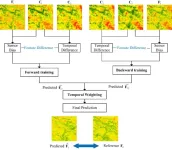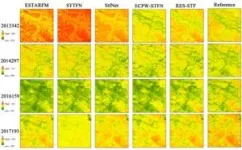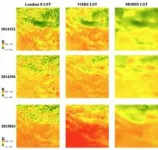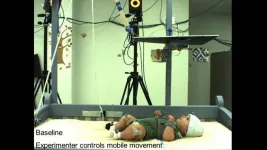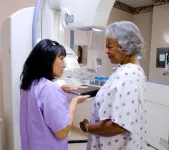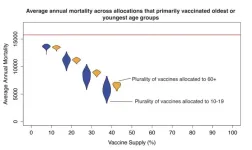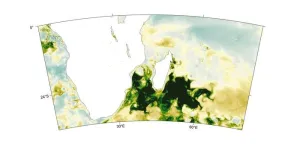(Press-News.org) Scientists need fine spatial and temporal resolution land surface temperature (LST) data for many types of research and applications. Spatio-temporal fusion, a technique that combines data from multiple sources to create high-resolution images with both spatial (space) and temporal (time) details, is an important solution for researchers needing fine spatio-temporal resolution LST data. A team of researchers propose a new spatio-temporal fusion method based on Restormer (RES-STF).
Their work is published in the Journal of Remote Sensing on August 21, 2024.
LST data, the measurement of how hot the Earth’s surface is from a satellite’s point of view, is an important tool in monitoring global change. High spatio-temporal resolution LST data has many practical applications and plays a crucial role in guiding agricultural practices, irrigation, and drainage, as well as in studying urban heat environment changes. However, because of limitations in the remote sensing sensors’ hardware design, trade-off always exists between temporal and spatial resolution in satellite-derived LST data.
Scientists acquire the LST data from thermal infrared remote sensing images collected by various satellite sensors, such as Landsat TM/ETM+/TIRS, Moderate Resolution Imaging Spectroradiometer (MODIS), Advanced Very High-Resolution Radiometer (AVHRR), Advanced Spaceborne Thermal Emission and Reflection Radiometer (ASTER), and Visible Infrared Imaging Radiometer Suite (VIIRS).
Scientists can create 100-m, daily LST data by fusing 1-km, daily MODIS LST with 100-m, 16-day Landsat LST data. MODIS is a spectroradiometer instrument about the Terra and Aqua satellites. Landsat are Earth-observing satellites. But in recent years the quality of MODIS LST products has been decreasing noticeably, which greatly impacts fusion accuracy. So the research team proposes replacing the MODIS LST data with LST data from the Visible Infrared Imaging Radiometer Suite (VIIRS) in spatio-temporal fusion. The VIIRS instrument flies aboard Joint Polar Satellite System.
To handle the data discrepancy that results because of the large difference in overpass time between VIIRS LST and Landsat LST, the team proposes the spatio-temporal fusion method based on Restoration Transformer, or Restormer. Restormer is a model that handles large-scale data, and it combines the advantages of convolutional neural networks and the Transformer model. The convolutional neural networks offer multi-scale feature extraction and Transformer provides global dependency to effectively capture both local and global information in the images. The research team’s proposed Restormer spatio-temporal fusion method is called RES-STF and it copes with the challenges brought by different overpass time when fusing VIIRS and LANDSAT LST.
“The problem we aimed to address in this paper is the challenge of selection of suitable alternative daily time-series LST data for spatio-temporal fusion with Landsat LST, which provides fine spatial resolution, but coarse temporal resolution, to create 100-m, daily LST,” said Qunming Wang, a professor at Tongji University. “The strategy of using VIIRS LST presents greater quality and leads to more accurate fusion results,” said Wang.
“The most important message is that VIIRS LST data are an effective alternative to MODIS LST in the spatio-temporal fusion task for creating 100-m, daily LST. Also, the proposed RES-STF method can cope with the data discrepancy brought by different overpass time when fusing VIIRS and Landsat LST,” said Ruijie Huang, a master student at Tongji University. The team’s research showed that RES-STF shows strong robustness through experiments in three different regions. It is also more accurate than one typical non-deep learning-based method, and three typical deep learning-based methods. Compared to the MODIS LST data, the VIIRS LST data contains richer spatial texture information which leads to more accurate fusion results.
Looking ahead, the team’s next step is to enhance the deep learning-based spatio-temporal fusion method RES-STF, especially when training data are difficult to collect, and combine other feasible data to deal with LST with great spatio-temporal heterogeneity. “Our ultimate goal is to obtain fine spatial and temporal resolution LST with great quality, providing critical data for studying urban heat environment changes and guiding agricultural practices, irrigation and drainage,” said Wang.
The research team includes Qunming Wang and Ruijie Huang from the College of Surveying and Geo-Informatics, Tongji University, Shanghai, China.
This research was supported by the National Natural Science Foundation of China.
END
Researchers develop method to obtain fine spatial and temporal resolution land surface temperature data
Combines VIIRS LST and Landsat LST data
2024-10-01
ELSE PRESS RELEASES FROM THIS DATE:
Feet first: AI reveals how infants connect with their world
2024-10-01
Recent advances in computing and artificial intelligence, along with insights into infant learning, suggest that machine and deep learning techniques can help us study how infants transition from random exploratory movements to purposeful actions. Most research has focused on babies’ spontaneous movements, distinguishing between fidgety and non-fidgety behaviors.
While early movements may seem chaotic, they reveal meaningful patterns as infants interact with their environment. However, we still lack understanding of how infants intentionally engage with their surroundings and the principles guiding their ...
Addressing health equity in childhood asthma requires engaging affected communities
2024-10-01
NEW YORK, NY (Oct. 1, 2024) – Systemic racism remains a significant challenge in efforts to address health disparities in childhood asthma. A new American Thoracic Society report provides practical frameworks to begin the research necessary to make real progress in treating asthma in Black and Latino children, who are more likely than their white counterparts to report to emergency rooms in the U.S.
Stephanie Lovinsky-Desir, MD, and a diverse group of researchers, clinicians, social scientists and community health workers shared their findings in the report published online this week in ...
Light-based microcapillary monitoring sparks innovation in manufacturing and biotechnology
2024-10-01
Dr. Jaeyeon Pyo of the Smart 3D Printing Research Team at the Korea Electrotechnology Research Institute (KERI) has developed a breakthrough technology that uses light to visualize nanoscale glass microcapillary tips, enabling precise and delicate contact with other objects.
A “‘Microcapillary” is a precision tool with a very small aperture (0.1 mm to 0.000010 mm in diameter) fabricated from a glass tube. It is utilized as a vital tool in various fields, from biotechnology to manipulate cells, to micro electroplating and nano 3D printing. Specifically, it is used in biotechnology faor tasks such as injecting sperm into an egg during in vitro fertilization (IVF) ...
Global effort to map the human brain releases first data
2024-10-01
Seattle, WA – October 1, 2024 – The BRAIN Initiative® Cell Atlas Network (BICAN) has launched its first major data release, marking a significant milestone in the ambitious effort to map the whole human brain.
The data, accessible through the BICAN Rapid Release Inventory, includes single-cell and single-nucleus transcriptomic and epigenomic profiles from humans, mice, and 10 other mammalian species. Sourced from multiple grants and labs within the consortium, including the Allen Institute, these data are from projects that aim to identify and define brain cell types based on molecular profiles.
“The ...
Scientists discover planet orbiting closest single star to our Sun
2024-10-01
Using the European Southern Observatory’s Very Large Telescope (ESO’s VLT), astronomers have discovered an exoplanet orbiting Barnard’s star, the closest single star to our Sun. On this newly discovered exoplanet, which has at least half the mass of Venus, a year lasts just over three Earth days. The team’s observations also hint at the existence of three more exoplanet candidates, in various orbits around the star.
Located just six light-years away, Barnard’s star is the second-closest stellar system — after Alpha Centauri’s three-star group — and the closest individual star to us. Owing to its proximity, it is a primary target in ...
New ACS report: Breast cancer mortality continues three decade decline overall, but steeper increases in incidence for women
2024-10-01
The American Cancer Society (ACS) today released Breast Cancer Statistics, 2024, the organization’s biennial update on breast cancer occurrence and trends in the United States. The new report finds breast cancer mortality rates overall have dropped by 44% since 1989, averting approximately 517,900 breast cancer deaths. However, not all women have benefited from this progress, notably American Indian and Alaska Native (AIAN) women, whose rates have remained unchanged over the past three decades. Also concerning ...
Immigrants to the United States still assimilate
2024-10-01
Children of immigrants to the United States typically incorporate themselves into US economic and cultural life, and this pattern of assimilation has not markedly changed in over a century. Today, one in seven US residents was born abroad, rates similar to those seen in the late nineteenth century. As immigrants’ countries of origin have shifted from Europe to Asia and the Americas, a narrative has developed that contemporary immigrants do not assimilate as thoroughly as older immigrants. But is this true? In a Perspective, Ran Abramitzky and Leah Boustan summarize their long-running research program matching individuals across historical US Censuses. The authors compare ...
Vaccinating the young to save the old in the Tropics
2024-10-01
A model suggests that vaccinating children and teens against the flu can help protect the elderly in tropical countries. Influenza kills up to 650,000 people worldwide every year. In part due to the lack of strong seasonality and differences in vaccine supply, optimal vaccination strategies for the tropics may differ from those in temperate zones. Joseph Servadio and colleagues parameterized an age-structured mathematical model of influenza transmission to the asynchronous, non-annual epidemiology of tropical influenza in Vietnam, a country with low vaccine coverage. The model includes three subtypes of the flu virus. Vaccinating year-round was found to be ...
Climate change, drought, dust, and plankton blooms
2024-10-01
A study links an unusual plankton bloom off the coast of Madagascar to drought in Southern Africa. Climate warming has intensified droughts around the world. When vegetation dies from lack of water, the wind can pick up and carry unprotected soil particles for thousands of kilometers. These dust particles can then act as fertilizer when deposited in seawater. Dionysios Raitsos and colleagues show that dust from drought-stricken Southern Africa caused a bloom of marine phytoplankton off the southeast Madagascar coast from November 2019 through February 2020. The team used standardized anomalies of dust aerosol optical depth from the Copernicus ...
Nudges fail to reduce online hate
2024-10-01
Seven nudges aiming to reduce hateful speech online all failed—but the nudges unexpectedly succeeded in increasing engagement with harmless and wholesome content. Controlling hate speech is an ongoing challenge for online communities. In a pre-registered experiment, Tatiana Celadin and colleagues compared the effects of seven “nudges,” messages designed to promote prosocial behaviors: reminding posters of descriptive norms, injunctive norms, or personal norms; cooling down negative emotions; stimulating deliberation or empathy; and highlighting reputation. Over 4,000 Americans recruited through the online platform ...
LAST 30 PRESS RELEASES:
Scientists trace microplastics in fertilizer from fields to the beach
The Lancet Obstetrics, Gynecology, & Women’s Health: Taking paracetamol during pregnancy does not increase risk of autism, ADHD or intellectual disabilities, confirms new gold-standard evidence review
Taking paracetamol during pregnancy does not increase risk of autism, ADHD or intellectual disabilities
Harm reduction vending machines in New York State expand access to overdose treatment and drug test strips, UB studies confirm
University of Phoenix releases white paper on Credit for Prior Learning as a catalyst for internal mobility and retention
Canada losing track of salmon health as climate and industrial threats mount
Molecular sieve-confined Pt-FeOx catalysts achieve highly efficient reversible hydrogen cycle of methylcyclohexane-toluene
Investment in farm productivity tools key to reducing greenhouse gas
New review highlights electrochemical pathways to recover uranium from wastewater and seawater
Hidden pollutants in shale gas development raise environmental concerns, new review finds
Discarded cigarette butts transformed into high performance energy storage materials
Researchers highlight role of alternative RNA splicing in schizophrenia
NTU Singapore scientists find new way to disarm antibiotic-resistant bacteria and restore healing in chronic wounds
Research suggests nationwide racial bias in media reporting on gun violence
Revealing the cell’s nanocourier at work
Health impacts of nursing home staffing
Public views about opioid overdose and people with opioid use disorder
Age-related changes in sperm DNA may play a role in autism risk
Ambitious model fails to explain near-death experiences, experts say
Multifaceted effects of inward foreign direct investment on new venture creation
Exploring mutations that spontaneously switch on a key brain cell receptor
Two-step genome editing enables the creation of full-length humanized mouse models
Pusan National University researchers develop light-activated tissue adhesive patch for rapid, watertight neurosurgical sealing
Study finds so-called super agers tend to have at least two key genetic advantages
Brain stimulation device cleared for ADHD in the US is overall safe but ineffective
Scientists discover natural ‘brake’ that could stop harmful inflammation
Tougher solid electrolyte advances long-sought lithium metal batteries
Experts provide policy roadmap to reduce dementia risk
New 3D imaging system could address limitations of MRI, CT and ultrasound
First-in-human drug trial lowers high blood fats
[Press-News.org] Researchers develop method to obtain fine spatial and temporal resolution land surface temperature dataCombines VIIRS LST and Landsat LST data
